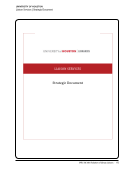186 · Representative Documents: Program Evolution
UNIVERSITY OF KANSAS
Organizational Review Team Report |Organizational Recommendations |Research and Learning Division
KU Libraries: Organizational Review Team Report
32
Research and Learning Division
Liaison Model
Some two years ago in June 2011, the consultants retained by the libraries noted, “The liaison role is not well
defined, nor does staff view it as flexible. While a variety of approaches exist, mixed results in faculty outreach
coupled with communicating the results of that outreach, hamper organizational effectiveness” (Lougee and
Luce, 2011).
The consultants also noted there was “uneven engagement” among liaisons and departments and that greater
“clarity was needed for position definitions…” (Lougee and Luce, 2011, p. 3).
Not long after the consultants’ report was submitted, an internal libraries task force was formed called
Connecting to KU Teaching &Research Departments, which submitted recommendations to the libraries’
administration in September 2010. That report recognized the libraries deliver services to departments along
a “continuum of multiple [liaison] models,” but assessment of the libraries’ efforts revealed several service gaps
that warranted greater attention. For example, the task force noted the libraries’ use aspects of the “traditional
departmental liaison model,” the “embedded knowledge model,” and the “resource team model,” none of
which delivered a full suite of services to teaching and research departments on campus (Connecting to KU…,
2010, pp. 5-7). Indeed, several gaps in the models used to serve departments were noted, including these:
• knowledge of scholarly communications and trends
• instruction and research support
• data/collections resources and services
• assessment
• technology skills
• marketing/outreach
While “next steps” were proposed to address such gaps, no further action was taken at that time. Subsequently,
there was no organizational consensus reached regarding the role of subject liaisons following either the
consultants visit or the work of the internal task force.
Mindful of these efforts, ORT discussed the notion of liaisons and liaison models several times during the fall
semester. It should be noted, however, that ORT had only three library faculty as members, not all of whom
currently serve as traditional “liaisons.” Focus group discussions did not add much clarity to questions surrounding
the current liaison model, and the team did not reach consensus regarding whether or not subject specialist
designations should be retained in the newly proposed structure.
Notwithstanding that, ORT recommends the designation “liaison” be discontinued and that a new model
of outreach be considered and renamed. It may be advisable, for example, to refer to these specialists as
“consultants” or some other name. The term “liaison” is based on an older model that stressed collection
development, reference, and instruction as the primary responsibilities of all liaisons, no matter the discipline
served. Within this context, liaisons were assigned specific disciplines to serve and developed established and
formal relationships with departments, schools, or centers across campus. At times, these units work closely with
faculty assigned as their library liaison (not all academic units have faculty liaisons).
ORGANIZATIONAL RECOMMENDATIONS
UNIVERSITY OF KANSAS
Organizational Review Team Report |Organizational Recommendations |Research and Learning Division
KU Libraries: Organizational Review Team Report
32
Research and Learning Division
Liaison Model
Some two years ago in June 2011, the consultants retained by the libraries noted, “The liaison role is not well
defined, nor does staff view it as flexible. While a variety of approaches exist, mixed results in faculty outreach
coupled with communicating the results of that outreach, hamper organizational effectiveness” (Lougee and
Luce, 2011).
The consultants also noted there was “uneven engagement” among liaisons and departments and that greater
“clarity was needed for position definitions…” (Lougee and Luce, 2011, p. 3).
Not long after the consultants’ report was submitted, an internal libraries task force was formed called
Connecting to KU Teaching &Research Departments, which submitted recommendations to the libraries’
administration in September 2010. That report recognized the libraries deliver services to departments along
a “continuum of multiple [liaison] models,” but assessment of the libraries’ efforts revealed several service gaps
that warranted greater attention. For example, the task force noted the libraries’ use aspects of the “traditional
departmental liaison model,” the “embedded knowledge model,” and the “resource team model,” none of
which delivered a full suite of services to teaching and research departments on campus (Connecting to KU…,
2010, pp. 5-7). Indeed, several gaps in the models used to serve departments were noted, including these:
• knowledge of scholarly communications and trends
• instruction and research support
• data/collections resources and services
• assessment
• technology skills
• marketing/outreach
While “next steps” were proposed to address such gaps, no further action was taken at that time. Subsequently,
there was no organizational consensus reached regarding the role of subject liaisons following either the
consultants visit or the work of the internal task force.
Mindful of these efforts, ORT discussed the notion of liaisons and liaison models several times during the fall
semester. It should be noted, however, that ORT had only three library faculty as members, not all of whom
currently serve as traditional “liaisons.” Focus group discussions did not add much clarity to questions surrounding
the current liaison model, and the team did not reach consensus regarding whether or not subject specialist
designations should be retained in the newly proposed structure.
Notwithstanding that, ORT recommends the designation “liaison” be discontinued and that a new model
of outreach be considered and renamed. It may be advisable, for example, to refer to these specialists as
“consultants” or some other name. The term “liaison” is based on an older model that stressed collection
development, reference, and instruction as the primary responsibilities of all liaisons, no matter the discipline
served. Within this context, liaisons were assigned specific disciplines to serve and developed established and
formal relationships with departments, schools, or centers across campus. At times, these units work closely with
faculty assigned as their library liaison (not all academic units have faculty liaisons).
ORGANIZATIONAL RECOMMENDATIONS












































































































































































































